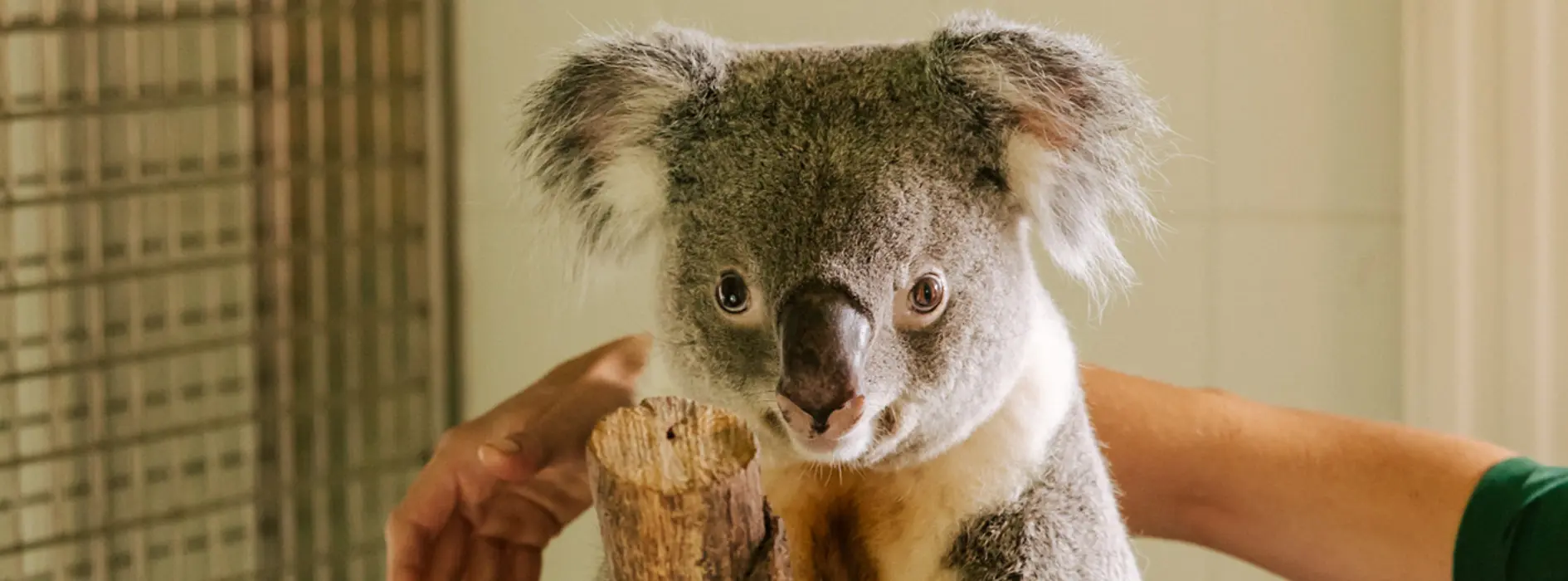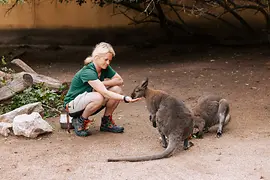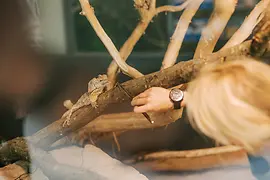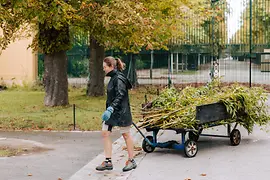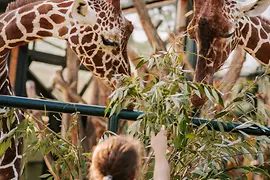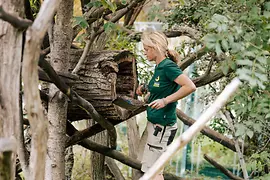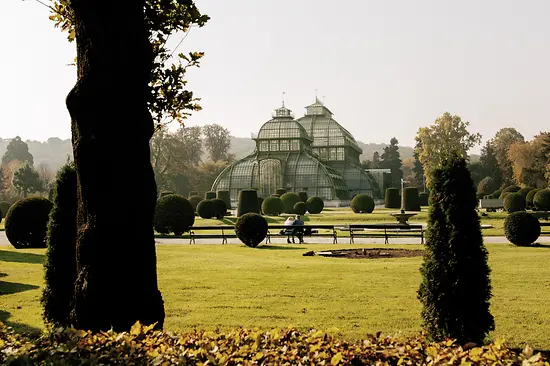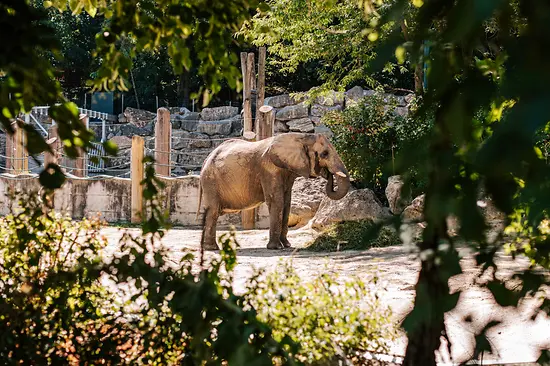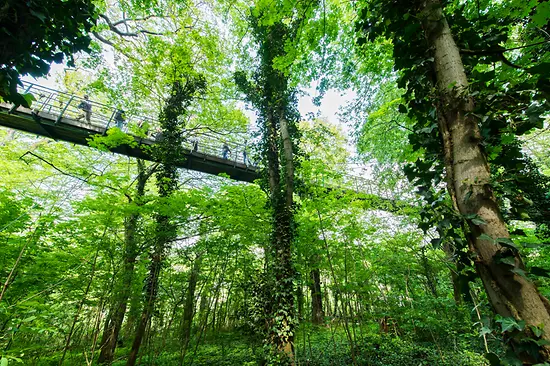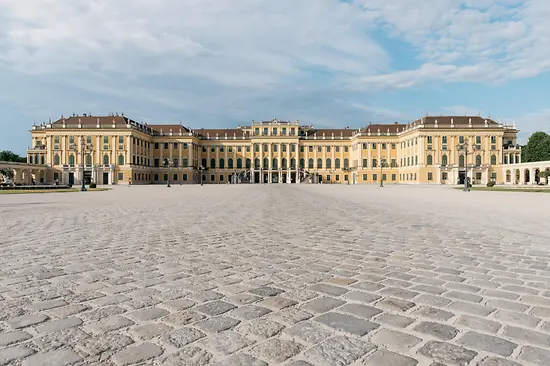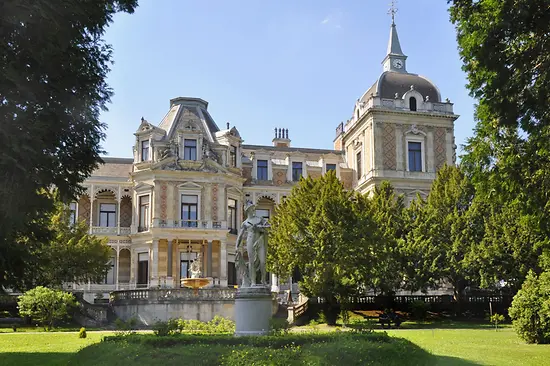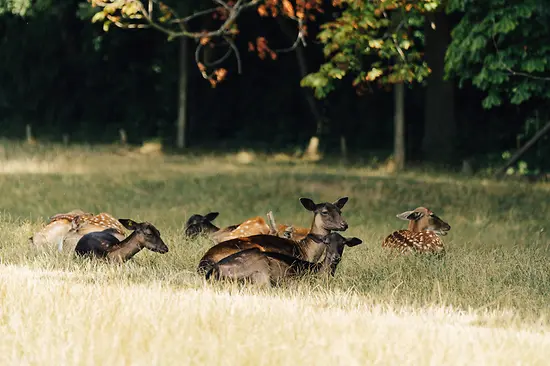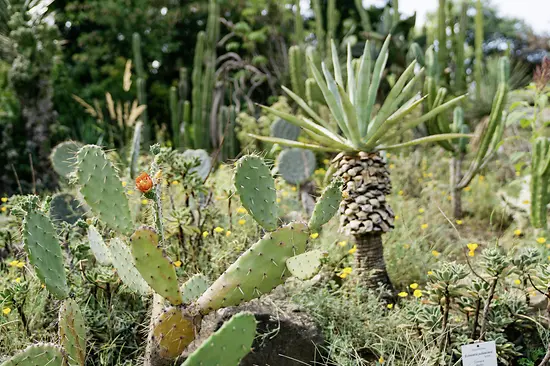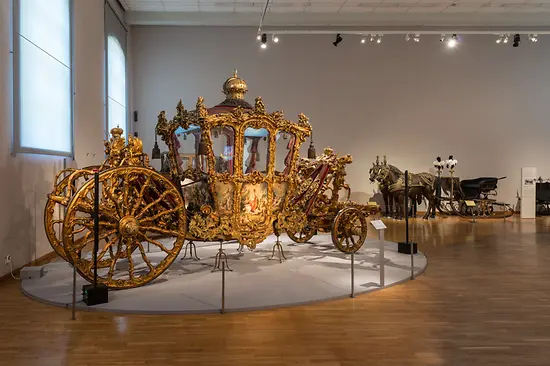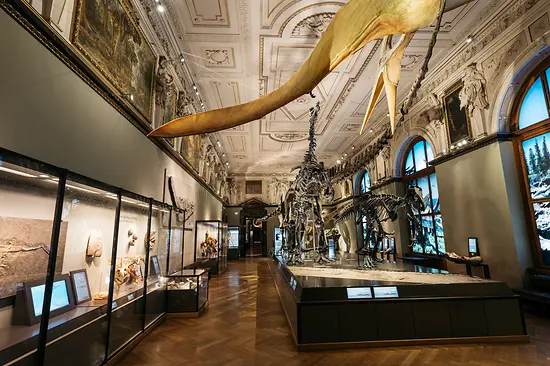A Day at the Zoo
Stanislaus, Viktor and Sam stare at us with sleepy eyes. The three Bennett’s kangaroo joeys at Schönbrunn Zoo are not used to this kind of commotion during their morning feeding session. It is shortly before eight in the morning on a warm August day. Senior keeper Gerlinde Hillebrand has already been on duty tending to her young charges for half an hour. We have the honor of looking over her shoulder as she does her rounds. She knows “her” animals very well: “Stanislaus is sensitive and easily spooked. Sam, though, is the most trusting,” she reveals. Hillebrand and her seven colleagues are responsible for taking care of the dayto- day needs of the kangaroos, koalas, giant pandas, giraffes, ground and southern hornbills, dwarf mongooses, rats, red pandas, frilled-neck lizards and blue-tongued skinks.
Her place of work is the world’s oldest zoo still in operation today (founded in 1752 by Emperor Franz I Stephan, husband of Maria Theresa). It is also one of the most modern. Schönbrunn has been named Europe’s Best Zoo six times. And with good reason: in the 1990s, the historic, cramped cages were replaced with spacious, modern habitats tailored to each species. The area where once lions lived out a sorry existence is now a viewing area for visitors – who numbered an impressive 2.3 million per year before COVID.
“We inspire people.”
Stephan Hering-Hagenbeck took up the reins at the zoo on January 1, 2020, putting him in charge of 8,500 animals from 700 species, as well as a team of around 260 employees, 90 of whom, like Hillebrand, work as zookeepers. In an interview, he reveals how important zoos are: “Science-led zoological gardens are enormously important in today’s society. In an increasingly urbanized world, people are coming into contact with nature less and less often. In big cities, a zoo could easily be the only place where people can experience nature. Today more than ever, I see this as the core task that falls to zoological gardens. We inspire people with our animals and that helps to spark their interest in nature and conservation. Of course, I love to watch nature documentaries, but it makes a huge difference if I have the opportunity to experience the animals live with all the senses.”
“The koalas are our divas”
With Gerlinde Hillebrand at our side, we’re now with the kangaroos’ next-door neighbors: the koalas. There are three of them living at the zoo at the moment: a male called Wirri Wirri, a female called Bunji and their daughter Millaa Millaa. “The koalas are our divas,” says Hillebrand with a smile. But not just due to the airs and graces they like to put on (and rarely get to display, given that they sleep for up to 18 hours a day), but because they have very specific hygiene and dietary requirements. Koalas only eat eucalyptus. Which in their case is sourced from Belgium, England and Switzerland – as well as from Vienna’s 11th district: “They particularly love the locally sourced variety because it is still so fresh when it reaches them.” And we can see that: we cannot remember ever seeing such sprightly koalas as the two females when the trained biologist brings eucalyptus to their enclosure. And afterwards it’s digestion and nap time. Wirri Wirri has to wait a little while longer before he gets his portion. He is being weighed on a branch affixed to a set of scales. So that he keeps still. “9.1 kilograms. The ideal weight,” says the Upper Austria-born keeper with satisfaction.
While we are still with the koalas, Hillebrand’s colleague Lea Hagler is busy preparing something to eat for the zoo’s other picky eaters: this time it’s bamboo, for giant pandas Yang Yang and Yuan Yuan. Their highly specialized diet means that they barely eat anything else. The bamboo comes from the south of France – and also Burgenland here in Austria. “Between April and October around 300 kg come from Burgenland to Vienna each week, where it’s stored at 8° Celsius,” Hagler explains. Bears like these get through around 30 kilos of the stuff each day. And because bamboo is just as difficult to digest as eucalyptus, there’s a lot of sleeping in the panda enclosure, too.
Mr. Pomeroy, Escape Artist Extraordinaire
By contrast, Mr. Pomeroy, who lives a few meters farther on, is much quicker on his feet. This strange southern hornbill shares his living space with the giraffes. But sometimes it seems like he tires of their company, regularly slipping out of the giraffe park before pacing around the zoo and proudly showing visitors all the insects he has caught before gobbling them up. Afterwards, he makes his way home all on his own. Giraffes Obi and Fleur are currently tucking into some tasty maple leaves courtesy of Magdalena Höllerer. The two animals and their keeper are separated by a fence. Hillebrand tells us: “We are extremely cautious in our interactions with animals that could be potentially dangerous to us. There are strict guidelines in place.” If a giraffe does lash out with a kick, then it’s best to keep a safe distance.
In fact, no one cuddles the animals here, contrary to popular belief. Although they live in Schönbrunn, all of the animals are wild. Being a zookeeper is not an easy job: “50 percent of our work is cleaning the enclosures. And in the case of the larger animals, which produce a correspondingly high amount of dung, it can be backbreaking,” Hillebrand adds.
“I’m not squeamish.”
It’s clearly not a job for the faint-hearted. The 45-year-old, who wrote her diploma on parasites and her dissertation on cockroaches, admits: “I’m not squeamish. Which is a good thing because we also have to kill animals such as mice – which other people think are cute – for our hornbills. And insects like crickets that are a favorite of the frilled-neck lizards and blue-tongued skins aren’t exactly everyone’s cup of tea.”
The zoo workers’ job also involves keeping the animals occupied so that they don’t get bored. Enrichment is the name of the game. It involves things like putting food in hard-to-reach places or setting up a ball pool for the red pandas. The zoo also has an educational remit. “This means that we are always there to provide an explanation if a visitor has a question. It’s part of the job, it’s enjoyable and it helps get people interested in protecting endangered species.”
And how does she cope when an animal dies at the zoo? – “It’s definitely very emotional. I would be lying if I said it wasn’t. But it is also important, because if I end up so desensitized that the death of an animal no longer affects me, then I’m in the wrong job.” She concludes: “We have been looking after many of the animals for years. So it’s only natural that we develop a bond.”
“Schönbrunn is unique.”
We have reached the red pandas. They are a lot smaller than their black-and-white relatives and prefer to spend their time high above ground in the treetops. Today, they aren’t interested in bamboo, so the zookeeper cleans their “toilet” (a hollowed out log) instead and we make our way towards Zazu. A name that is probably familiar to many people from The Lion King: Zazu is one of the funny red-billed hornbills that are desperately trying to keep Simba safe from his uncle Scar and the gormless hyenas. Normally, Zazu swoops down greedily to feast on the mealworms that Hillebrand leaves out for him. But today, just like the red pandas, he gives us the cold shoulder and heads for the hills. “That’s just what wild animals are like. They don’t always do what we might expect. Which is perfectly natural.”
Our day with Hillebrand is gradually drawing to a close. We want to know how she responds to critics who are anti-zoo and bemoan the lack of space in the enclosures: “My job is to make sure that the animals are well looked after. Many people think that the most important thing is to ensure the animals have as much space as possible. But if I give the monkeys a gigantic enclosure without any trees, then they’re not going to like that. Structure and variety are important. And we make sure they have that.”
And are there any zoos in the world that are similar? – “Schönbrunn is definitely unique, bringing together Baroque architecture and contemporary animal care. You won’t find anything like it anywhere else. And to ensure that we continue to move with the times, it’s essential that we participate in scientific studies and implement the findings. It is an ongoing process – and one which is always in the animals’ best interests.”
And that includes building new facilities, as Hering-Hagenbeck reveals: “One of the major projects that I have taken on is the new aquarium. There are also plans to create a new elephant park on an additional piece of land to the south of the zoo. The latest attraction to open was a significantly larger enclosure for the Barbary sheep and Barbary apes, which we inaugurated in fall 2021.”
A walk through the oldest working zoo in the world soon reveals that the animals – including Stanislaus, Victor, Sam and friends – feel very much at home here.
Text: Robert Seydel
Schönbrunn Zoo offers numerous experiences, including feeding the giraffes, a behind-the-scenes look at the koalas’ lives and a face-to-face encounter with the Indian rhinos. For more information visit www.zoovienna.at
Schönbrunn Zoo Entrance via Hietzinger Tor/Hietzinger Hauptstraße
1130 Vienna
-
Vienna City Card
-
Benefits of the Vienna City Card: -15%
Additional information on the offer:
Standard ticket price: 27€
Savings: 4€
-
-
Opening times
-
January
- daily, 09:00 - 16:30
-
February
- daily, 09:00 - 17:00
-
March
- daily, 09:00 - 17:30
-
April
to
September
- daily, 09:00 - 18:30
-
October
to
December
- daily, 09:00 - 16:30
- ACHTUNG: Bis zur Umstellung auf die Winterzeit gelten im Oktober die September-Öffnungszeiten
-
January
-
Accessibility
-
Main entrance
- no steps (Swinging doors )
-
Car parks Main entrance
-
Parking spaces for people with disabilities
at Elisabethallee, entrance Tirolerhof
-
Parking spaces for people with disabilities
-
Further information
- Seeing eye dogs allowed
- Wheelchair accessible restroom available.
-
Special offers for people with disabilities
Tours for visitors with disabilities and special needs on request.
-
Comments
Access to buildings and enclosures without steps or via ramp.
-
Main entrance
